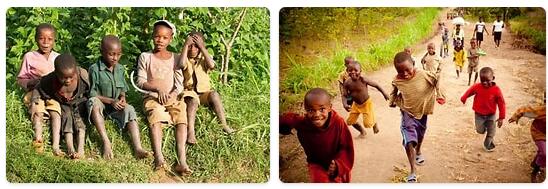Yearbook 2016
Rwanda. The current population of Rwanda is 12,952,229. Rwanda President Paul Kagame was preparing to continue in power. Despite criticism from the European Union, the United States and some international donors, Kagame announced in his New Year’s speech that he would seek re-election in 2017.

The strong economic growth and the fight against corruption is believed to benefit Kagame. In 2016, growth slowed somewhat, to about 6%, as a result of reduced demand in the mining sector. The World Bank points out that the country remains dependent on aid and that fluctuations in aid flows can affect the economy. Likewise, the government needs to improve the infrastructure and access to electricity to promote investment in the private sector.
According to the global anti-corruption organization Transparency International, Rwanda is one of Africa’s five least corrupt countries.
Human rights groups criticized the media and government opponents under continued pressure. In March, three former commanders, including a retired general, were sentenced to prison between five and 21 years. They were arrested in 2014 and charged with rioting and for supporting the RNC (Rwanda National Congress) opposition movement.
In October, a government reform was carried out. The Minister of Internal Security was abolished, as was the post of Minister of Mines.
According to thereligionfaqs, in July, Rwanda hosted a summit within the African Union (AU). Among the current heads of state were Sudan’s President Omar al-Bashir, who is wanted by the International Criminal Court (ICC) in The Hague for suspected war crimes and other crimes in Darfur. Rwanda emphasized that the country is not a member of the ICC. At the summit, the joint AU passport was launched, which is initially only given to politicians and diplomats.
The relationship with Burundi was strained when Rwanda’s military was appointed by UN investigators and the US envoy for the African Great Lakes region to try to recruit and train exile Burundians to overthrow Burundi’s president. Kagame and his foreign minister rejected this. Rwanda countered that the country wanted to move tens of thousands of Burundian refugees to other countries. Since 2015, more than 85,000 Burundians have moved to Rwanda according to the UN refugee agency UNHCR.
The Catholic Church in Rwanda issued an apology for its role and the participation of other Christians in the 1994 genocide. Two former mayors were given life sentences for similar crimes in a French trial. It was the longest sentence ever sentenced in France for the genocide.
Population and society
Rwanda is the second most densely populated state in Africa, with a population that, according to 2014 statistics, exceeds 490 residents per square kilometer. The sharply increasing population density risks damaging the fragile social balance. The civil war has left the country, in addition to the dead and refugees, thousands of orphans and people in prison awaiting trial. Almost 80% of Rwandans depend on agriculture for their livelihood.
65.9% of the adult population is literate, but only 6% received higher education. After the civil war, the Rwandan government made the reconstruction and upgrading of the school system one of its main priorities. The country’s life expectancy, albeit still low, is growing progressively and from the 27 years of the early 1990s to 64 in 2013.
After the war, the Tutsis, who were already in the minority, further declined and are now estimated to represent only 15% of the population. They link their history to the pastoral aristocracy that ruled the kingdom of Rwanda, founded by the first king (mwami) Ruganzu I Bwimba between the fifteenth and sixteenth centuries, and formally abolished only in 1959. The Hutus, the majority group, are a Bantu population traditionally devoted to agriculture and in the postcolonial state has often provided cheap wage labor. A very small minority (1%) is made up of twa, skilled hunters and pygmoid gatherers: they are poorly integrated into society and are often regarded as pariahs.
Official languages of Rwanda are Kinyarwanda, spoken by the entire population, French, the language of the former Belgian ruler, used in higher education, and English, used for business and commerce. Kiswahili (or Swahili), the vehicular language of East Africa, is spoken in many areas. The vast majority of the population is Christian (56.5% Catholics and 37% Protestants), even if there are not a few syncretic contaminations with traditional rites and beliefs.
Respect for human rights remains highly at risk in a political system that is formally presented as multi-party, but in fact far from a true democratic dialectic. Some members of the parties antagonistic to the RPF, the Parti Social Démocrate (Psd) and the Parti Libéral (Pl), ministers were appointed to the current government. This too contributes to ensuring that there is no real parliamentary opposition activity. Corruption of the police, unsustainable conditions in prisons and evident limits to the freedom of the press and of expression constitute the reference framework for a substantially authoritarian regime, which has no scruple to hit opponents, even using the legislation that banishes ethnic divisions. Although women are daily disadvantaged compared to men in accessing education, medical care and the main social and economic resources, Rwanda has maintained the primacy of the country with the highest percentage of women in parliament for two consecutive terms. Gender representation has been favored by the breakdown of archaic social patterns caused by the civil war, by the investments made in the education sector and by the constitution, according to which at least 30% of deputies must be women.